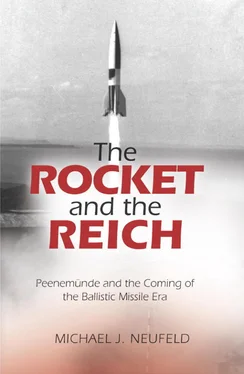Michael Neufeld - The Rocket and the Reich
Здесь есть возможность читать онлайн «Michael Neufeld - The Rocket and the Reich» весь текст электронной книги совершенно бесплатно (целиком полную версию без сокращений). В некоторых случаях можно слушать аудио, скачать через торрент в формате fb2 и присутствует краткое содержание. Город: Washington, Год выпуска: 2013, ISBN: 2013, Издательство: Smithsonian Books, Жанр: История, military_weapon, на английском языке. Описание произведения, (предисловие) а так же отзывы посетителей доступны на портале библиотеки ЛибКат.
- Название:The Rocket and the Reich
- Автор:
- Издательство:Smithsonian Books
- Жанр:
- Год:2013
- Город:Washington
- ISBN:978-1-58834-466-3
- Рейтинг книги:3 / 5. Голосов: 1
-
Избранное:Добавить в избранное
- Отзывы:
-
Ваша оценка:
- 60
- 1
- 2
- 3
- 4
- 5
The Rocket and the Reich: краткое содержание, описание и аннотация
Предлагаем к чтению аннотацию, описание, краткое содержание или предисловие (зависит от того, что написал сам автор книги «The Rocket and the Reich»). Если вы не нашли необходимую информацию о книге — напишите в комментариях, мы постараемся отыскать её.
The Rocket and the Reich — читать онлайн бесплатно полную книгу (весь текст) целиком
Ниже представлен текст книги, разбитый по страницам. Система сохранения места последней прочитанной страницы, позволяет с удобством читать онлайн бесплатно книгу «The Rocket and the Reich», без необходимости каждый раз заново искать на чём Вы остановились. Поставьте закладку, и сможете в любой момент перейти на страницу, на которой закончили чтение.
Интервал:
Закладка:
Once von Braun had found the site, things moved quickly. On January 6, 1936, von Horstig and von Richthofen, both now lieutenant colonels, met at the Air Ministry regarding the layout of the new joint center. Twelve days later Ordnance sketched out a division of territory roughly corresponding to the eventual Luftwaffe and Army facilities at Peenemünde-West and Peenemünde-East. Construction was assigned to the Luftwaffe. Dornberger says that decision was made because the rocket group were enamored of the Luftwaffe’s architectural style, which ran toward Nazi neoclassicism. Of much greater importance, however, was the “entirely new, fantastic, unbureaucratic, fast-moving, decisive” character of Luftwaffe administration, to use the words of project engineer Arthur Rudolph. The Ordnance group had often been frustrated by the ponderous and penny-pinching Army bureaucracy in the early years of the program. 20
Choosing a site was one thing; arranging for the money to pay for it was another. The Air Ministry started the ball rolling with a promise of 5 million marks. The remaining funds came from the Army in a display of interservice rivalry. Von Braun gives this account:
General Becker… was wrathfully indignant at the impertinence of the Junior Service.
“Just like that upstart Luftwaffe,” he growled, “no sooner do we come up with a promising development than they try to pinch it! But they’ll find that they’re the junior partners in the rocket business!”
“Do you mean,” asked [Lieutenant] Colonel von Horstig in astonishment, “that you propose to spend more than five millions on rocketry?”
“Exactly that,” retorted Becker, “I intend to appropriate six millions on top of von Richthofen’s five!”
In this manner our modest effort[,] whose yearly budget had never exceeded 80,000 marks, emerged into what the Americans call the “big time.” 21
The Luftwaffe leadership had little problem spending such a large amount of money on the rocket, but the Army High Command needed further convincing. According to Dornberger, “Becker told me in January 1936, ‘If you want more money, you have to prove that your rocket is of military value.’ ” In March—probably not long after Germany successfully remilitarized the Rhineland in defiance of the Western powers—the Commander-in-Chief of the Army, General Werner Freiherr von Fritsch, was brought to Kummersdorf for rocket motor firings and a detailed briefing. After hearing Ordnance’s plans for the future, he posed the blunt question: “How much do you want?” The answer must have been even more than the 6 million marks promised by Becker. The estimated construction cost of the Army side of Peenemünde alone was 11 million for 1936 and 6 million more for 1937–39, both amounts to be shared equally with the Luftwaffe. A yearly operating budget of about 3.5 million marks was projected for the Army facility. 22
Ultimately, to plan for the facilities and to justify this expense to the Army leadership, the ballistic missile had to become more concrete. In late March Walter Dornberger, Wernher von Braun, and Walter Riedel met to specify the characteristics of the A-4. The probable size of the engine was already known. According to Rudolph, the next engine-thrust goal had been set in late 1935 quite arbitrarily at 25 metric tons (55,000 pounds), nearly seventeen times more powerful than the 1,500-kg A-3 engine. Starting from that figure, estimates of engine efficiency, and the ratio of fueled to empty weight of the missile, it was possible to calculate combinations of range and payload. Dornberger cut through the discussions of his subordinates by laying down the following specifications:
I am an old long-range artillerist. The most famous gun up to that time was the Paris gun…. This gun fired 22 pounds over a range of 78 miles, but possessed terrible weight in the firing position and a terrible dispersion.
I wanted to eliminate this unhandy weight of the gun in the firing position by using a single-stage liquid fuel rocket to be launched vertically, and to be programmed later into an elevation of 45 degrees. The rocket should carry a hundred times the weight of the explosives of the Parisian gun [i.e., 1,000 kg]… over twice the range…
Furthermore, he wanted accuracy superior to conventional artillery: 50 percent of the missiles were to fall within a circle of two to three “mils”—artillery language for 0.2–0.3 percent of the total range. At the specified range of about 250 kilometers this accuracy was about half to three-quarters of a kilometer, far better than was feasible, it turned out. The missile’s fins were also to be narrow enough to fit through a standard European railroad tunnel. 23
Dornberger’s specifications reveal the flawed thinking that lay behind the German missile program from the outset. The Paris Gun had been the greatest technical accomplishment of German artillerists up to that time, yet it had failed to have much effect on the French in 1918. The gun was a triumph of narrow technological thinking: the technical fascination of being able to break through traditional limits and fire over such unprecedented distances had overwhelmed any rigorous analysis of its likely impact on enemy morale. The interwar German artillery community completely failed to grasp that point, however. Those specialists, led by Becker, saw the gun only in terms of artillery reaching its technological limits in muzzle velocity and range. 24Using the rocket as a ballistic missile certainly promised to eliminate the massive railroad-borne gun carriage and supporting equipment, to abolish all limits on range and to increase payload vastly. Yet the Army Ordnance missile enthusiasts must have understood that the investment required by the Reich would be huge, even if they underestimated the ultimate expenditure on Peenemünde and the A-4 by many times.
The most fundamental flaw in their thinking lay in the lack of any well-thought-out strategic concept of how the missile could actually affect the course of a war. Becker, Dornberger, and their associates counted on the psychological shock to the enemy of an unfamiliar and powerful weapon. Once that surprise had passed, they could only picture using the missile as a fairly accurate artillery shell against specific military and industrial targets. Interwar air power advocates, like the Italian General Guilio Douhet, had asserted that the strategic bombing of enemy cities would lead to the collapse of civilian morale, but the artillerists apparently ignored those theories. Dornberger, for example, did not contemplate using the A-4 as a terror weapon against whole cities until 1941. A comparison between the missile and the heavy bomber would have raised uncomfortable questions in any case. The development of that type of aircraft, unlike the ballistic missile, did not require a revolutionary leap in the technology of flight. 25
Thus, in a fundamental sense the A-4 was another Paris Gun. It was the product of a narrow technological vision that obscured the strategic bankruptcy of the concept. The fact that Dornberger was also a spaceflight enthusiast, like his chief liquid-fuel rocket engineers—von Braun, Riedel, and Rudolph—only reinforced his tendency to substitute technological enthusiasm for careful strategic thought.
Given the flawed military logic of Ordnance’s ballistic missile program, it is curious that the German Army leadership embraced it so readily. The blinkered strategic vision of German generals during the era of the two world wars is one likely explanation. The training and traditions of the Prussian Army officer corps after the Napoleonic era emphasized operational and tactical excellence at the expense of strategy and grand strategy. The political irresponsibility and strategic incompetence that tradition fostered were only furthered by a lack of effective civilian control over the military in the authoritarian systems of Prussia and the German empire. The result was the paradoxical combination of “battlefield brilliance” and strategic blundering that contributed so much to the “German catastrophe” of the twentieth century. In this context, it is easier to understand how Becker, Fritsch, and other generals might overestimate the effects of the A-4, or their predecessors the impact of the Paris Gun. 26
Читать дальшеИнтервал:
Закладка:
Похожие книги на «The Rocket and the Reich»
Представляем Вашему вниманию похожие книги на «The Rocket and the Reich» списком для выбора. Мы отобрали схожую по названию и смыслу литературу в надежде предоставить читателям больше вариантов отыскать новые, интересные, ещё непрочитанные произведения.
Обсуждение, отзывы о книге «The Rocket and the Reich» и просто собственные мнения читателей. Оставьте ваши комментарии, напишите, что Вы думаете о произведении, его смысле или главных героях. Укажите что конкретно понравилось, а что нет, и почему Вы так считаете.












